CHC50113 Diploma: CHCECE002 Health and Safety in Early Childhood Care
VerifiedAdded on 2023/03/20
|26
|6833
|51
Homework Assignment
AI Summary
This document presents a completed written assessment for the CHCECE002 unit, focusing on ensuring the health and safety of children in an early childhood education and care setting. The assessment, undertaken by a student at Open Colleges, addresses various aspects of child safety, including infection prevention strategies, indirect ways infections can spread, hygiene practices, respecting children's privacy, medication administration procedures, environmental factors impacting rest and sleep, supervision techniques, hazard identification and risk minimization, asthma management, and procedures for the safe collection of children. The student provides detailed answers to short answer questions, demonstrating an understanding of relevant legislation, policies, and best practices in the field. The assessment covers both indoor and outdoor environments, offering practical strategies for creating a safe and healthy learning environment for children. The student also references relevant sources to support their answers, showing a good understanding of the subject matter.
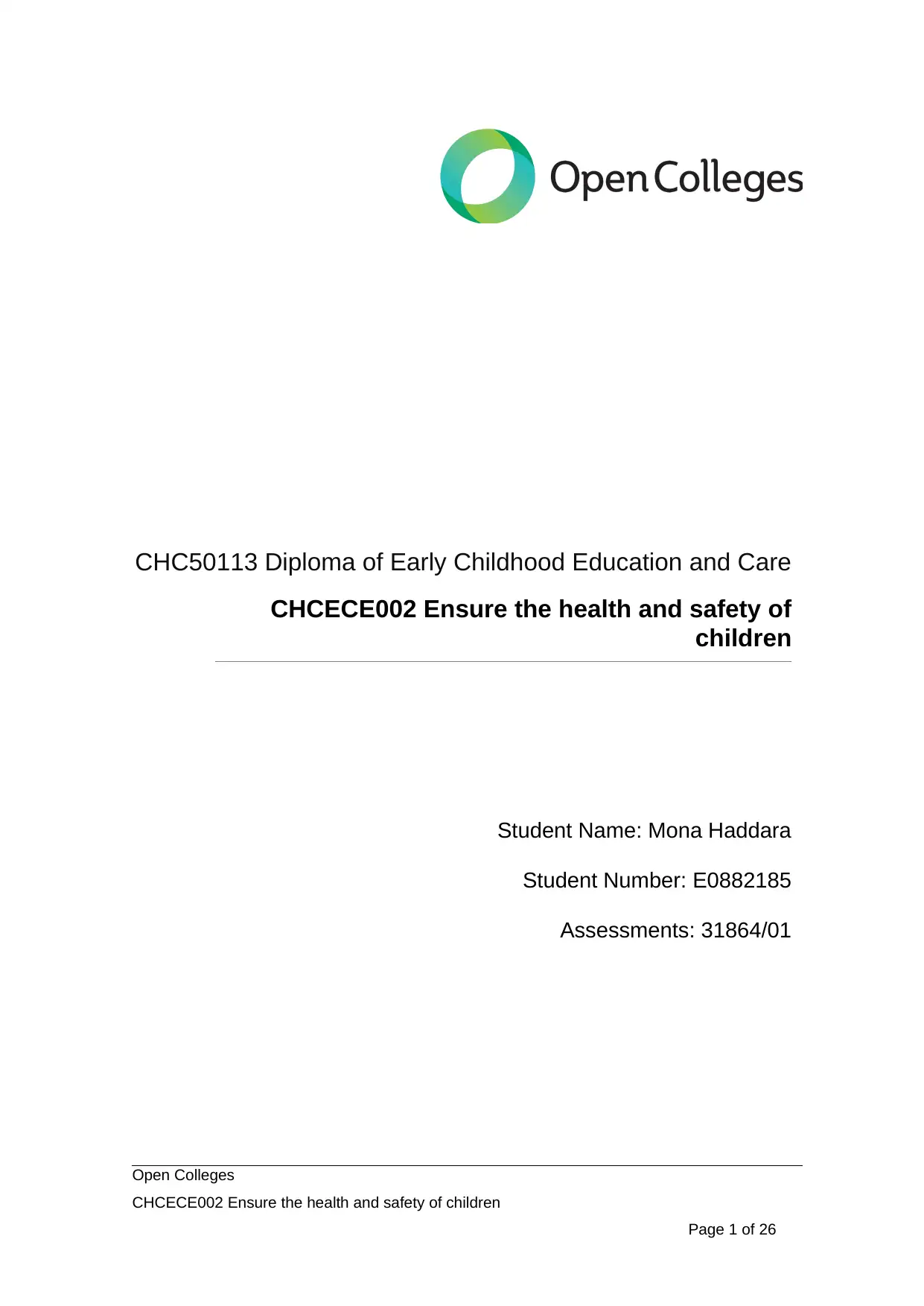
CHC50113 Diploma of Early Childhood Education and Care
CHCECE002 Ensure the health and safety of
children
Student Name: Mona Haddara
Student Number: E0882185
Assessments: 31864/01
Open Colleges
CHCECE002 Ensure the health and safety of children
Page 1 of 26
CHCECE002 Ensure the health and safety of
children
Student Name: Mona Haddara
Student Number: E0882185
Assessments: 31864/01
Open Colleges
CHCECE002 Ensure the health and safety of children
Page 1 of 26
Paraphrase This Document
Need a fresh take? Get an instant paraphrase of this document with our AI Paraphraser

All terms mentioned in this text that are known to be trademarks or service marks
have been appropriately capitalised. Use of a term in this text should not be
regarded as affecting the validity of any trademark or service mark.
© Open Colleges Pty Ltd, 2014
All rights reserved. No part of the material protected by this copyright may be
reproduced or utilised in any form or by any means, electronic or mechanical,
including photocopying, recording, or by any information storage and retrieval
system, without permission in writing from the copyright owner.
Open Colleges
CHCECE002 Ensure the health and safety of children
Page 2 of 26
have been appropriately capitalised. Use of a term in this text should not be
regarded as affecting the validity of any trademark or service mark.
© Open Colleges Pty Ltd, 2014
All rights reserved. No part of the material protected by this copyright may be
reproduced or utilised in any form or by any means, electronic or mechanical,
including photocopying, recording, or by any information storage and retrieval
system, without permission in writing from the copyright owner.
Open Colleges
CHCECE002 Ensure the health and safety of children
Page 2 of 26
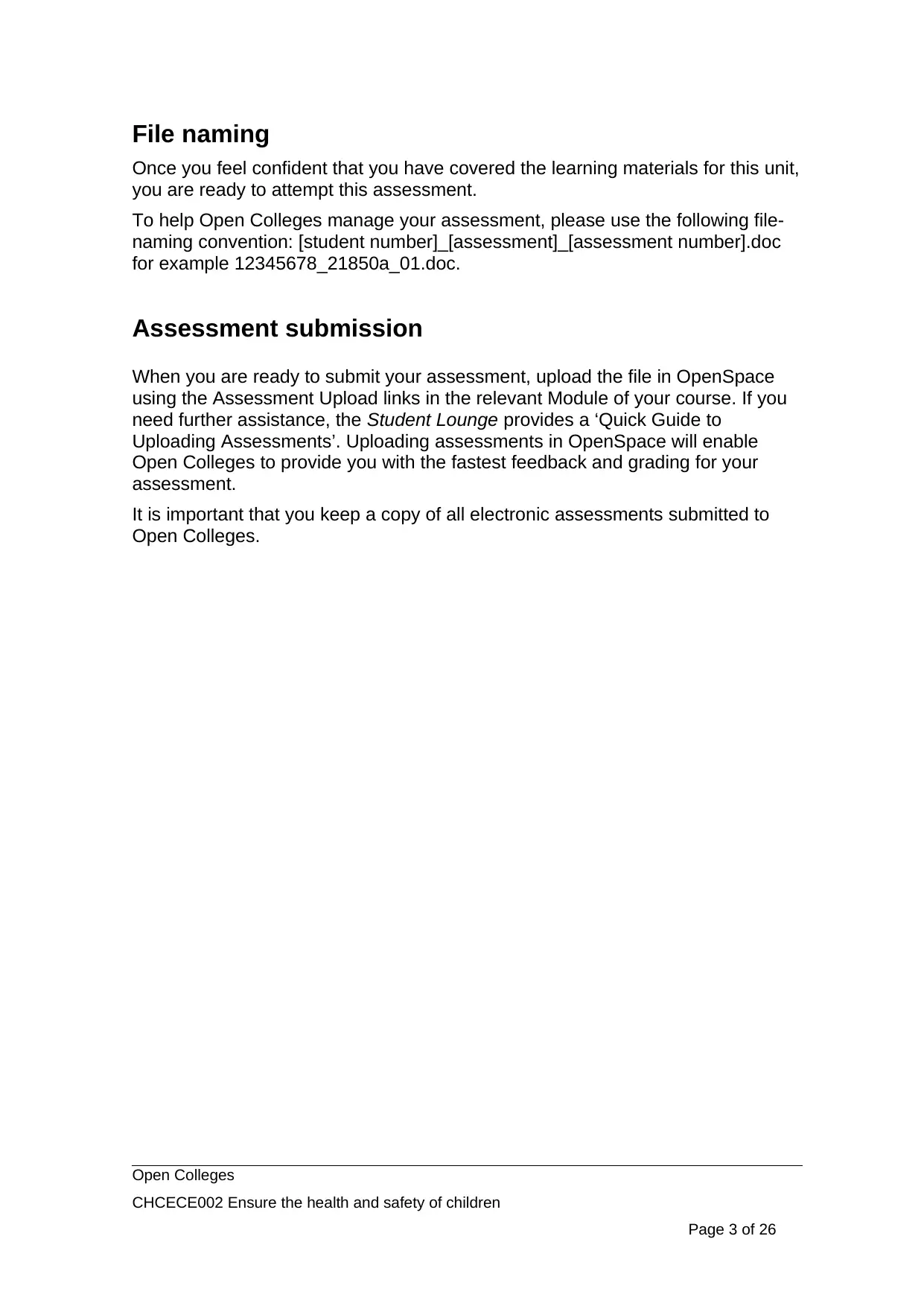
File naming
Once you feel confident that you have covered the learning materials for this unit,
you are ready to attempt this assessment.
To help Open Colleges manage your assessment, please use the following file-
naming convention: [student number]_[assessment]_[assessment number].doc
for example 12345678_21850a_01.doc.
Assessment submission
When you are ready to submit your assessment, upload the file in OpenSpace
using the Assessment Upload links in the relevant Module of your course. If you
need further assistance, the Student Lounge provides a ‘Quick Guide to
Uploading Assessments’. Uploading assessments in OpenSpace will enable
Open Colleges to provide you with the fastest feedback and grading for your
assessment.
It is important that you keep a copy of all electronic assessments submitted to
Open Colleges.
Open Colleges
CHCECE002 Ensure the health and safety of children
Page 3 of 26
Once you feel confident that you have covered the learning materials for this unit,
you are ready to attempt this assessment.
To help Open Colleges manage your assessment, please use the following file-
naming convention: [student number]_[assessment]_[assessment number].doc
for example 12345678_21850a_01.doc.
Assessment submission
When you are ready to submit your assessment, upload the file in OpenSpace
using the Assessment Upload links in the relevant Module of your course. If you
need further assistance, the Student Lounge provides a ‘Quick Guide to
Uploading Assessments’. Uploading assessments in OpenSpace will enable
Open Colleges to provide you with the fastest feedback and grading for your
assessment.
It is important that you keep a copy of all electronic assessments submitted to
Open Colleges.
Open Colleges
CHCECE002 Ensure the health and safety of children
Page 3 of 26
⊘ This is a preview!⊘
Do you want full access?
Subscribe today to unlock all pages.

Trusted by 1+ million students worldwide

Getting started
The assessment activities in this booklet have been designed to allow you to provide
evidence that demonstrates your competence in the unit CHCECE002 Ensure the
health and safety of children.
Your trainer will:
answer any questions that you might have about the assessment
assess your competence as required by the unit of competency, by making
judgments about the evidence you have presented in line with the rules of
evidence: validity, authenticity, currency and sufficiency
provide feedback on the outcomes of the assessment process.
Introduction
You are required to complete two assessment tasks for CHCECE002 Ensure the
health and safety of children.
In completing the final assessments, you will show evidence of your ability to:
support each child’s health needs
provide opportunities to meet each child’s need for sleep, rest and relaxation
implement effective hygiene and health practices
supervise children to ensure safety
minimise risks
contribute to the ongoing management of allergies
contribute to the ongoing management of asthma.
Assessment number Assessment deliverables
31484/01 Written assessment
31484/02 Project
Open Colleges
CHCECE002 Ensure the health and safety of children
Page 4 of 26
The assessment activities in this booklet have been designed to allow you to provide
evidence that demonstrates your competence in the unit CHCECE002 Ensure the
health and safety of children.
Your trainer will:
answer any questions that you might have about the assessment
assess your competence as required by the unit of competency, by making
judgments about the evidence you have presented in line with the rules of
evidence: validity, authenticity, currency and sufficiency
provide feedback on the outcomes of the assessment process.
Introduction
You are required to complete two assessment tasks for CHCECE002 Ensure the
health and safety of children.
In completing the final assessments, you will show evidence of your ability to:
support each child’s health needs
provide opportunities to meet each child’s need for sleep, rest and relaxation
implement effective hygiene and health practices
supervise children to ensure safety
minimise risks
contribute to the ongoing management of allergies
contribute to the ongoing management of asthma.
Assessment number Assessment deliverables
31484/01 Written assessment
31484/02 Project
Open Colleges
CHCECE002 Ensure the health and safety of children
Page 4 of 26
Paraphrase This Document
Need a fresh take? Get an instant paraphrase of this document with our AI Paraphraser
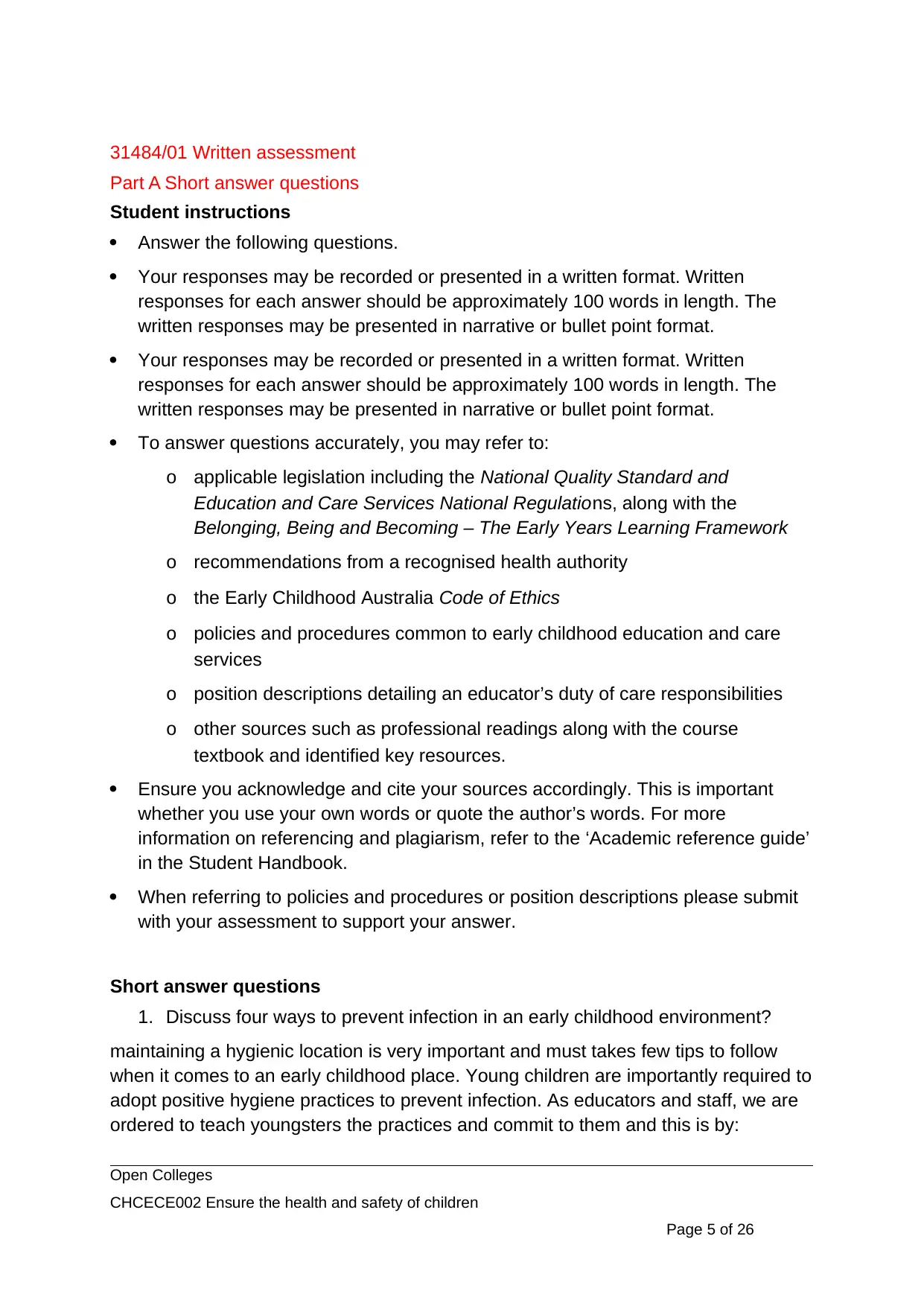
31484/01 Written assessment
Part A Short answer questions
Student instructions
Answer the following questions.
Your responses may be recorded or presented in a written format. Written
responses for each answer should be approximately 100 words in length. The
written responses may be presented in narrative or bullet point format.
Your responses may be recorded or presented in a written format. Written
responses for each answer should be approximately 100 words in length. The
written responses may be presented in narrative or bullet point format.
To answer questions accurately, you may refer to:
o applicable legislation including the National Quality Standard and
Education and Care Services National Regulations, along with the
Belonging, Being and Becoming – The Early Years Learning Framework
o recommendations from a recognised health authority
o the Early Childhood Australia Code of Ethics
o policies and procedures common to early childhood education and care
services
o position descriptions detailing an educator’s duty of care responsibilities
o other sources such as professional readings along with the course
textbook and identified key resources.
Ensure you acknowledge and cite your sources accordingly. This is important
whether you use your own words or quote the author’s words. For more
information on referencing and plagiarism, refer to the ‘Academic reference guide’
in the Student Handbook.
When referring to policies and procedures or position descriptions please submit
with your assessment to support your answer.
Short answer questions
1. Discuss four ways to prevent infection in an early childhood environment?
maintaining a hygienic location is very important and must takes few tips to follow
when it comes to an early childhood place. Young children are importantly required to
adopt positive hygiene practices to prevent infection. As educators and staff, we are
ordered to teach youngsters the practices and commit to them and this is by:
Open Colleges
CHCECE002 Ensure the health and safety of children
Page 5 of 26
Part A Short answer questions
Student instructions
Answer the following questions.
Your responses may be recorded or presented in a written format. Written
responses for each answer should be approximately 100 words in length. The
written responses may be presented in narrative or bullet point format.
Your responses may be recorded or presented in a written format. Written
responses for each answer should be approximately 100 words in length. The
written responses may be presented in narrative or bullet point format.
To answer questions accurately, you may refer to:
o applicable legislation including the National Quality Standard and
Education and Care Services National Regulations, along with the
Belonging, Being and Becoming – The Early Years Learning Framework
o recommendations from a recognised health authority
o the Early Childhood Australia Code of Ethics
o policies and procedures common to early childhood education and care
services
o position descriptions detailing an educator’s duty of care responsibilities
o other sources such as professional readings along with the course
textbook and identified key resources.
Ensure you acknowledge and cite your sources accordingly. This is important
whether you use your own words or quote the author’s words. For more
information on referencing and plagiarism, refer to the ‘Academic reference guide’
in the Student Handbook.
When referring to policies and procedures or position descriptions please submit
with your assessment to support your answer.
Short answer questions
1. Discuss four ways to prevent infection in an early childhood environment?
maintaining a hygienic location is very important and must takes few tips to follow
when it comes to an early childhood place. Young children are importantly required to
adopt positive hygiene practices to prevent infection. As educators and staff, we are
ordered to teach youngsters the practices and commit to them and this is by:
Open Colleges
CHCECE002 Ensure the health and safety of children
Page 5 of 26
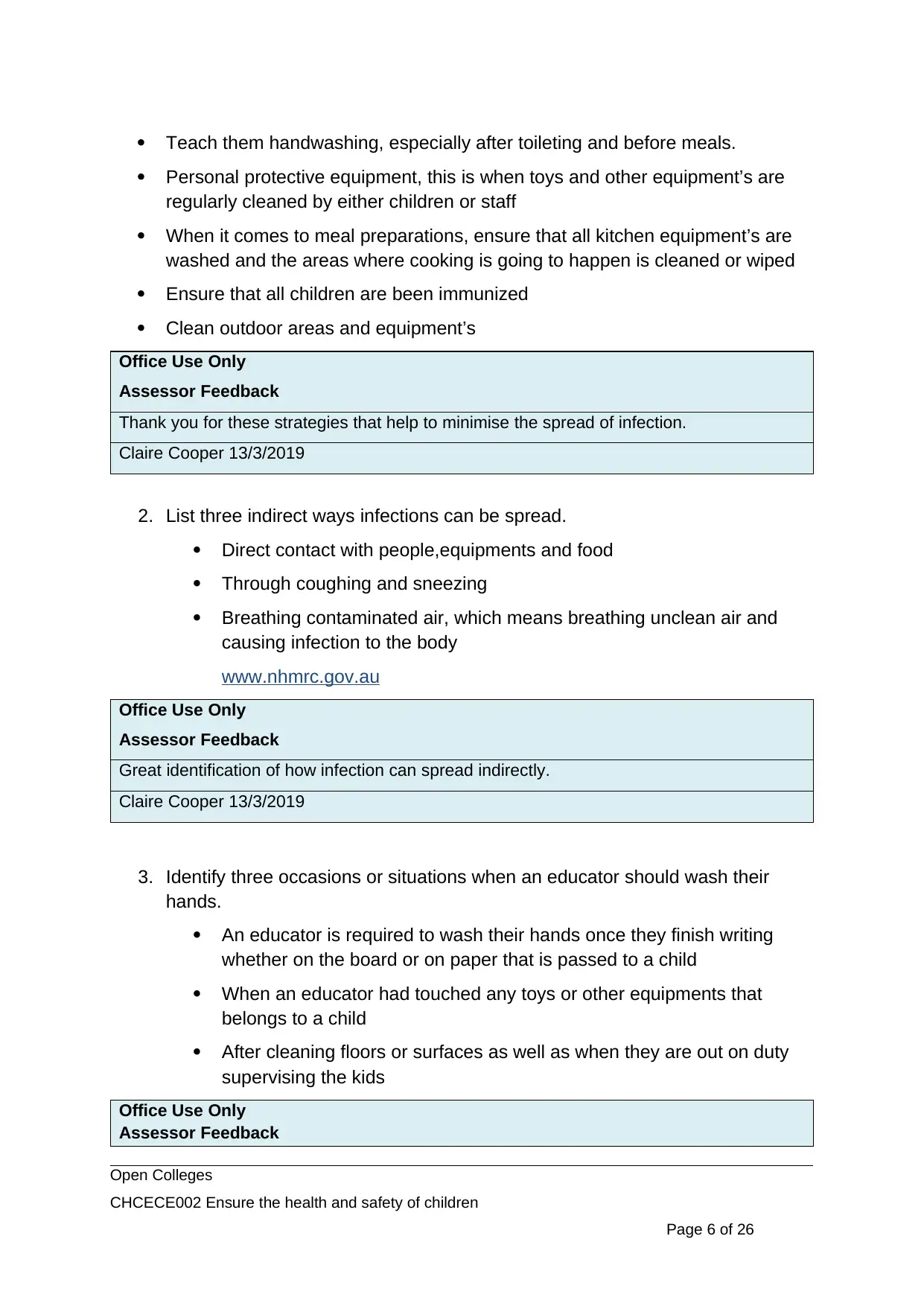
Teach them handwashing, especially after toileting and before meals.
Personal protective equipment, this is when toys and other equipment’s are
regularly cleaned by either children or staff
When it comes to meal preparations, ensure that all kitchen equipment’s are
washed and the areas where cooking is going to happen is cleaned or wiped
Ensure that all children are been immunized
Clean outdoor areas and equipment’s
Office Use Only
Assessor Feedback
Thank you for these strategies that help to minimise the spread of infection.
Claire Cooper 13/3/2019
2. List three indirect ways infections can be spread.
Direct contact with people,equipments and food
Through coughing and sneezing
Breathing contaminated air, which means breathing unclean air and
causing infection to the body
www.nhmrc.gov.au
Office Use Only
Assessor Feedback
Great identification of how infection can spread indirectly.
Claire Cooper 13/3/2019
3. Identify three occasions or situations when an educator should wash their
hands.
An educator is required to wash their hands once they finish writing
whether on the board or on paper that is passed to a child
When an educator had touched any toys or other equipments that
belongs to a child
After cleaning floors or surfaces as well as when they are out on duty
supervising the kids
Office Use Only
Assessor Feedback
Open Colleges
CHCECE002 Ensure the health and safety of children
Page 6 of 26
Personal protective equipment, this is when toys and other equipment’s are
regularly cleaned by either children or staff
When it comes to meal preparations, ensure that all kitchen equipment’s are
washed and the areas where cooking is going to happen is cleaned or wiped
Ensure that all children are been immunized
Clean outdoor areas and equipment’s
Office Use Only
Assessor Feedback
Thank you for these strategies that help to minimise the spread of infection.
Claire Cooper 13/3/2019
2. List three indirect ways infections can be spread.
Direct contact with people,equipments and food
Through coughing and sneezing
Breathing contaminated air, which means breathing unclean air and
causing infection to the body
www.nhmrc.gov.au
Office Use Only
Assessor Feedback
Great identification of how infection can spread indirectly.
Claire Cooper 13/3/2019
3. Identify three occasions or situations when an educator should wash their
hands.
An educator is required to wash their hands once they finish writing
whether on the board or on paper that is passed to a child
When an educator had touched any toys or other equipments that
belongs to a child
After cleaning floors or surfaces as well as when they are out on duty
supervising the kids
Office Use Only
Assessor Feedback
Open Colleges
CHCECE002 Ensure the health and safety of children
Page 6 of 26
⊘ This is a preview!⊘
Do you want full access?
Subscribe today to unlock all pages.

Trusted by 1+ million students worldwide

Thank you for including 3 appropriate examples.
Claire Cooper 13/3/2019
4. Describe two ways you can respect a child’s need for privacy during toileting,
dressing and undressing times.
Giving children a space if they choose to dress by themselves and respect
their indepenency
Educators must be protective when it comes to children’s privacy. This
involves toilet areas, changing times and so on
Office Use Only
Assessor Feedback
These are excellent ways to support a child’s independence and show respect, Mona.
Claire Cooper 13/3/2019
5. Complete the following sentences about the correct way to administer
medication.
a. Medication given to a child in care must be authorised by the parents
.
b. The medication must be clearly marked with the child’s
name .
c. The medication must not exceed the use by date .
d. The medication must be in its original packaging .
e. The parents must fill in a medication authorisation form for the child with the
name of the medication, amount, time, time of last does, and
Parent’s signature .
f. Medication should be stored well away from food, drink and out of reach of
children .
Office Use Only
Assessor Feedback
Well done these are the correct requirements when administrating medication.
Please note:
Medication given to a child in care must be authorised by the parent.
The parents must fill in a medication authorisation form for the child with the name
of the medication, amount, time, time of last dose and parent’s signature.
Medication should be stored well away from food, drink and out of reach of
children.
Open Colleges
CHCECE002 Ensure the health and safety of children
Page 7 of 26
Claire Cooper 13/3/2019
4. Describe two ways you can respect a child’s need for privacy during toileting,
dressing and undressing times.
Giving children a space if they choose to dress by themselves and respect
their indepenency
Educators must be protective when it comes to children’s privacy. This
involves toilet areas, changing times and so on
Office Use Only
Assessor Feedback
These are excellent ways to support a child’s independence and show respect, Mona.
Claire Cooper 13/3/2019
5. Complete the following sentences about the correct way to administer
medication.
a. Medication given to a child in care must be authorised by the parents
.
b. The medication must be clearly marked with the child’s
name .
c. The medication must not exceed the use by date .
d. The medication must be in its original packaging .
e. The parents must fill in a medication authorisation form for the child with the
name of the medication, amount, time, time of last does, and
Parent’s signature .
f. Medication should be stored well away from food, drink and out of reach of
children .
Office Use Only
Assessor Feedback
Well done these are the correct requirements when administrating medication.
Please note:
Medication given to a child in care must be authorised by the parent.
The parents must fill in a medication authorisation form for the child with the name
of the medication, amount, time, time of last dose and parent’s signature.
Medication should be stored well away from food, drink and out of reach of
children.
Open Colleges
CHCECE002 Ensure the health and safety of children
Page 7 of 26
Paraphrase This Document
Need a fresh take? Get an instant paraphrase of this document with our AI Paraphraser
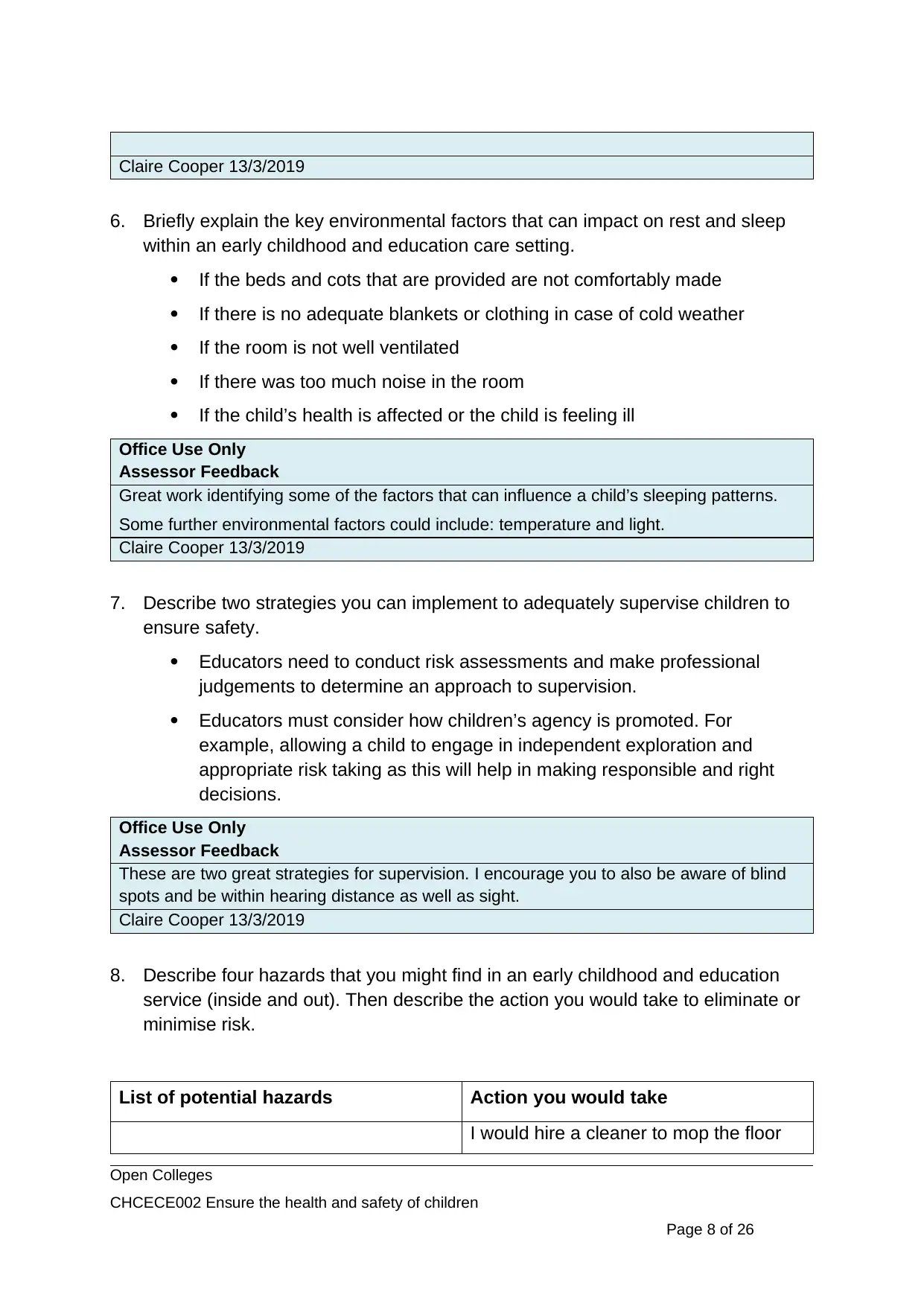
Claire Cooper 13/3/2019
6. Briefly explain the key environmental factors that can impact on rest and sleep
within an early childhood and education care setting.
If the beds and cots that are provided are not comfortably made
If there is no adequate blankets or clothing in case of cold weather
If the room is not well ventilated
If there was too much noise in the room
If the child’s health is affected or the child is feeling ill
Office Use Only
Assessor Feedback
Great work identifying some of the factors that can influence a child’s sleeping patterns.
Some further environmental factors could include: temperature and light.
Claire Cooper 13/3/2019
7. Describe two strategies you can implement to adequately supervise children to
ensure safety.
Educators need to conduct risk assessments and make professional
judgements to determine an approach to supervision.
Educators must consider how children’s agency is promoted. For
example, allowing a child to engage in independent exploration and
appropriate risk taking as this will help in making responsible and right
decisions.
Office Use Only
Assessor Feedback
These are two great strategies for supervision. I encourage you to also be aware of blind
spots and be within hearing distance as well as sight.
Claire Cooper 13/3/2019
8. Describe four hazards that you might find in an early childhood and education
service (inside and out). Then describe the action you would take to eliminate or
minimise risk.
List of potential hazards Action you would take
I would hire a cleaner to mop the floor
Open Colleges
CHCECE002 Ensure the health and safety of children
Page 8 of 26
6. Briefly explain the key environmental factors that can impact on rest and sleep
within an early childhood and education care setting.
If the beds and cots that are provided are not comfortably made
If there is no adequate blankets or clothing in case of cold weather
If the room is not well ventilated
If there was too much noise in the room
If the child’s health is affected or the child is feeling ill
Office Use Only
Assessor Feedback
Great work identifying some of the factors that can influence a child’s sleeping patterns.
Some further environmental factors could include: temperature and light.
Claire Cooper 13/3/2019
7. Describe two strategies you can implement to adequately supervise children to
ensure safety.
Educators need to conduct risk assessments and make professional
judgements to determine an approach to supervision.
Educators must consider how children’s agency is promoted. For
example, allowing a child to engage in independent exploration and
appropriate risk taking as this will help in making responsible and right
decisions.
Office Use Only
Assessor Feedback
These are two great strategies for supervision. I encourage you to also be aware of blind
spots and be within hearing distance as well as sight.
Claire Cooper 13/3/2019
8. Describe four hazards that you might find in an early childhood and education
service (inside and out). Then describe the action you would take to eliminate or
minimise risk.
List of potential hazards Action you would take
I would hire a cleaner to mop the floor
Open Colleges
CHCECE002 Ensure the health and safety of children
Page 8 of 26

Slippery floors
Sun exposure
when its wet. Teach children how to
wash their hands in the correct way
without splashing water everywhere
Sun exposure
I would ask children to wear their hats
every time they come out in the sun or
stay in shades during the times when
the sun heat is severe. Also apply
sunscreen
Dangerous playgrounds
Keep young children’s away from
playing in dangerous areas and coming
across risky playgrounds
Misuse of medication and dangerous
equipments
Place medications and harmful
equipment’s in high closets to keep out
of reach of children. This involves
scissors, stapler, Panadol and so on
Office Use Only
Assessor Feedback
Mona, these are some great, practical strategies – well done!
Claire Cooper 13/3/2019
9. Identify six signs that you should look for in an attack of asthma, which may
indicate an appropriate time for a child to use an asthma reliever.
Chest tightness and pain
Breathing difficulties
Having trouble sleeping due to wheezing and coughing
Feeling very tired when exercising
Facing mood alterations
Changes in lung functions
weather conditions, such as sudden change in temperature, cold air,
windy days, poor air quality and hot
https://www.webmd.com/asthma/guide/asthma-symptoms#1
Office Use Only
Assessor Feedback
You have accurately identified symptoms of Asthma. Please ensure that you use reliable
websites when researching. For reliable and up to date information about Asthma, I
recommend –
https://www.nationalasthma.org.au/understanding-asthma/what-is-asthma
Claire Cooper 13/3/2019
Open Colleges
CHCECE002 Ensure the health and safety of children
Page 9 of 26
Sun exposure
when its wet. Teach children how to
wash their hands in the correct way
without splashing water everywhere
Sun exposure
I would ask children to wear their hats
every time they come out in the sun or
stay in shades during the times when
the sun heat is severe. Also apply
sunscreen
Dangerous playgrounds
Keep young children’s away from
playing in dangerous areas and coming
across risky playgrounds
Misuse of medication and dangerous
equipments
Place medications and harmful
equipment’s in high closets to keep out
of reach of children. This involves
scissors, stapler, Panadol and so on
Office Use Only
Assessor Feedback
Mona, these are some great, practical strategies – well done!
Claire Cooper 13/3/2019
9. Identify six signs that you should look for in an attack of asthma, which may
indicate an appropriate time for a child to use an asthma reliever.
Chest tightness and pain
Breathing difficulties
Having trouble sleeping due to wheezing and coughing
Feeling very tired when exercising
Facing mood alterations
Changes in lung functions
weather conditions, such as sudden change in temperature, cold air,
windy days, poor air quality and hot
https://www.webmd.com/asthma/guide/asthma-symptoms#1
Office Use Only
Assessor Feedback
You have accurately identified symptoms of Asthma. Please ensure that you use reliable
websites when researching. For reliable and up to date information about Asthma, I
recommend –
https://www.nationalasthma.org.au/understanding-asthma/what-is-asthma
Claire Cooper 13/3/2019
Open Colleges
CHCECE002 Ensure the health and safety of children
Page 9 of 26
⊘ This is a preview!⊘
Do you want full access?
Subscribe today to unlock all pages.

Trusted by 1+ million students worldwide
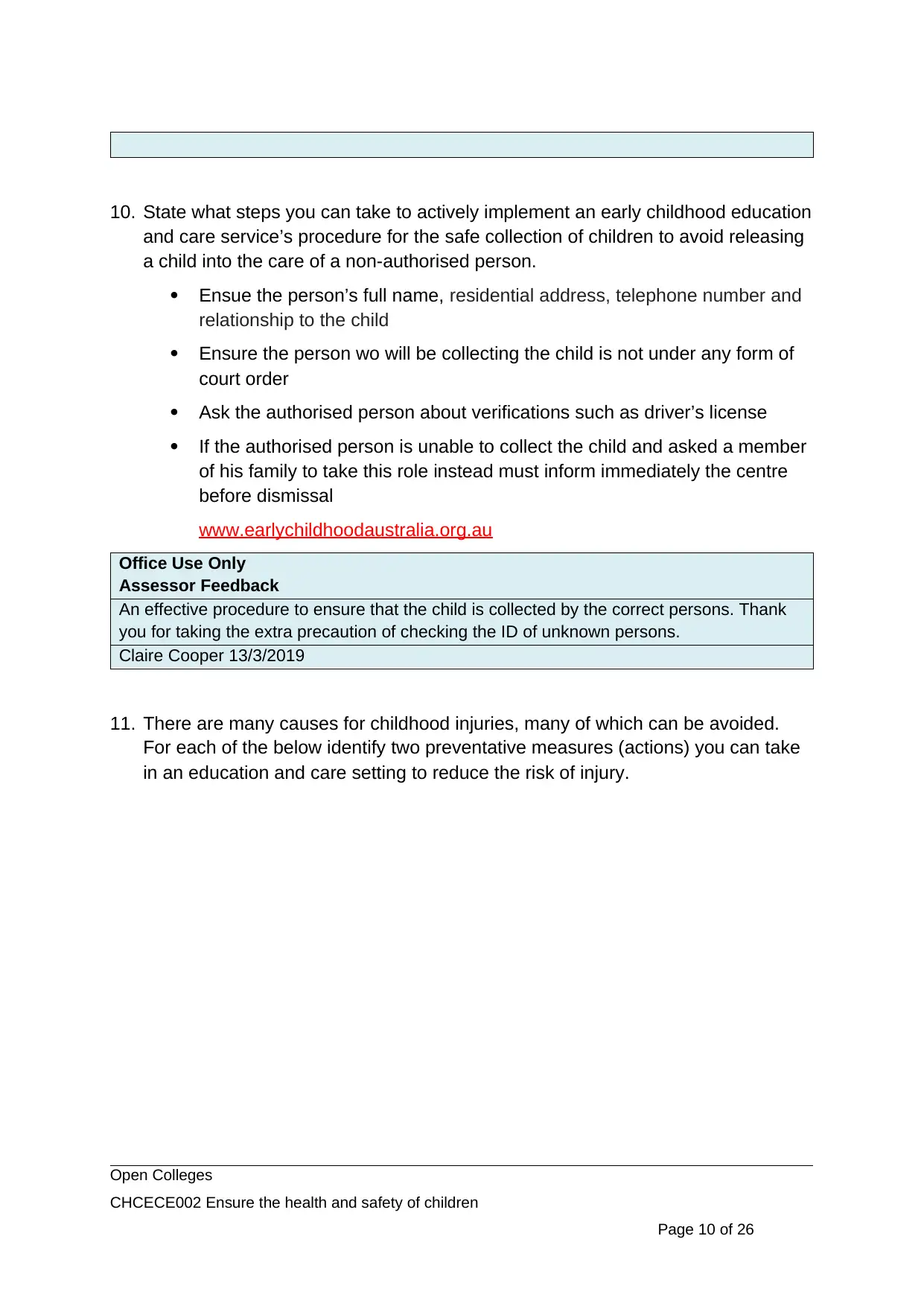
10. State what steps you can take to actively implement an early childhood education
and care service’s procedure for the safe collection of children to avoid releasing
a child into the care of a non-authorised person.
Ensue the person’s full name, residential address, telephone number and
relationship to the child
Ensure the person wo will be collecting the child is not under any form of
court order
Ask the authorised person about verifications such as driver’s license
If the authorised person is unable to collect the child and asked a member
of his family to take this role instead must inform immediately the centre
before dismissal
www.earlychildhoodaustralia.org.au
Office Use Only
Assessor Feedback
An effective procedure to ensure that the child is collected by the correct persons. Thank
you for taking the extra precaution of checking the ID of unknown persons.
Claire Cooper 13/3/2019
11. There are many causes for childhood injuries, many of which can be avoided.
For each of the below identify two preventative measures (actions) you can take
in an education and care setting to reduce the risk of injury.
Open Colleges
CHCECE002 Ensure the health and safety of children
Page 10 of 26
and care service’s procedure for the safe collection of children to avoid releasing
a child into the care of a non-authorised person.
Ensue the person’s full name, residential address, telephone number and
relationship to the child
Ensure the person wo will be collecting the child is not under any form of
court order
Ask the authorised person about verifications such as driver’s license
If the authorised person is unable to collect the child and asked a member
of his family to take this role instead must inform immediately the centre
before dismissal
www.earlychildhoodaustralia.org.au
Office Use Only
Assessor Feedback
An effective procedure to ensure that the child is collected by the correct persons. Thank
you for taking the extra precaution of checking the ID of unknown persons.
Claire Cooper 13/3/2019
11. There are many causes for childhood injuries, many of which can be avoided.
For each of the below identify two preventative measures (actions) you can take
in an education and care setting to reduce the risk of injury.
Open Colleges
CHCECE002 Ensure the health and safety of children
Page 10 of 26
Paraphrase This Document
Need a fresh take? Get an instant paraphrase of this document with our AI Paraphraser
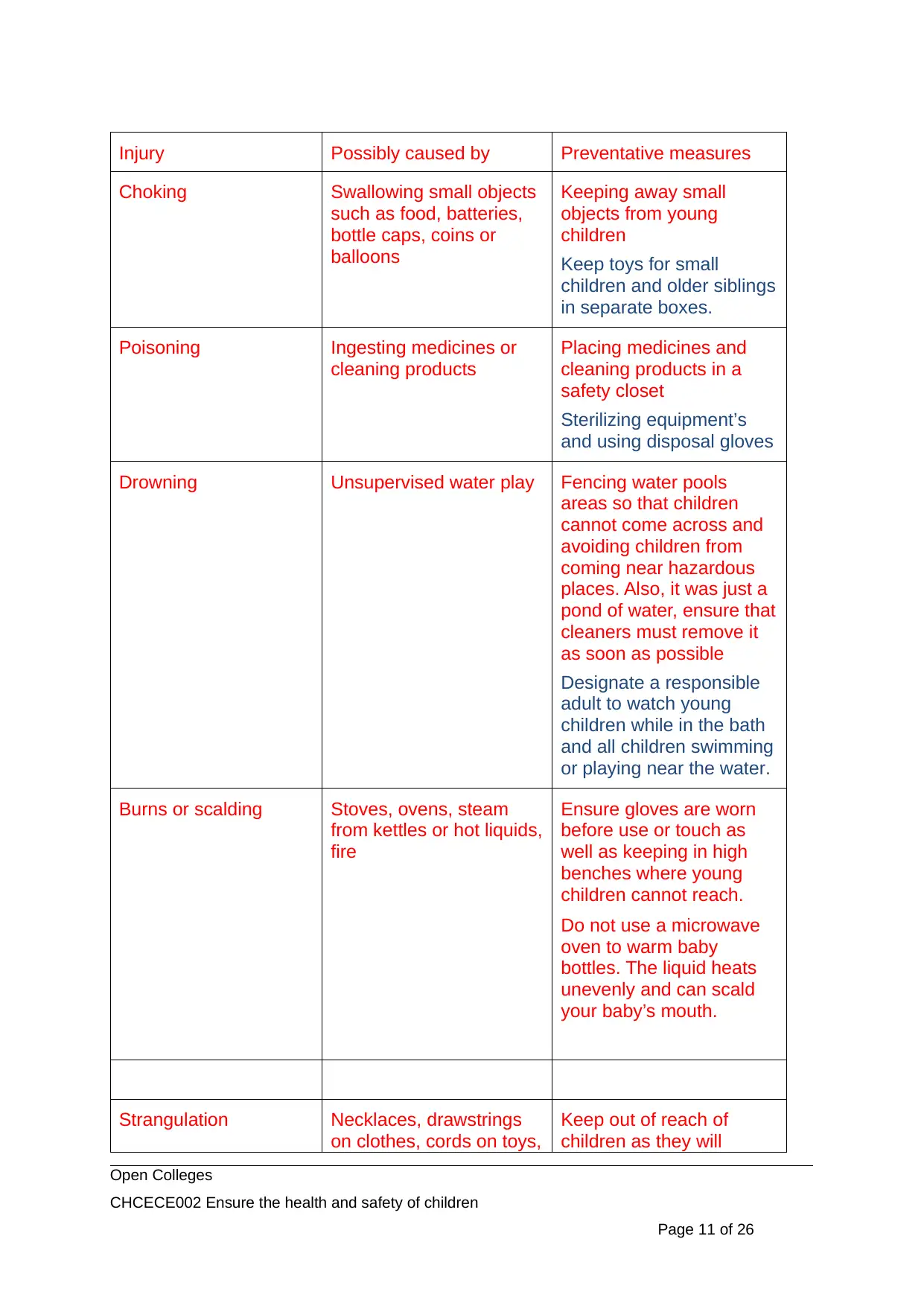
Injury Possibly caused by Preventative measures
Choking Swallowing small objects
such as food, batteries,
bottle caps, coins or
balloons
Keeping away small
objects from young
children
Keep toys for small
children and older siblings
in separate boxes.
Poisoning Ingesting medicines or
cleaning products
Placing medicines and
cleaning products in a
safety closet
Sterilizing equipment’s
and using disposal gloves
Drowning Unsupervised water play Fencing water pools
areas so that children
cannot come across and
avoiding children from
coming near hazardous
places. Also, it was just a
pond of water, ensure that
cleaners must remove it
as soon as possible
Designate a responsible
adult to watch young
children while in the bath
and all children swimming
or playing near the water.
Burns or scalding Stoves, ovens, steam
from kettles or hot liquids,
fire
Ensure gloves are worn
before use or touch as
well as keeping in high
benches where young
children cannot reach.
Do not use a microwave
oven to warm baby
bottles. The liquid heats
unevenly and can scald
your baby’s mouth.
Strangulation Necklaces, drawstrings
on clothes, cords on toys,
Keep out of reach of
children as they will
Open Colleges
CHCECE002 Ensure the health and safety of children
Page 11 of 26
Choking Swallowing small objects
such as food, batteries,
bottle caps, coins or
balloons
Keeping away small
objects from young
children
Keep toys for small
children and older siblings
in separate boxes.
Poisoning Ingesting medicines or
cleaning products
Placing medicines and
cleaning products in a
safety closet
Sterilizing equipment’s
and using disposal gloves
Drowning Unsupervised water play Fencing water pools
areas so that children
cannot come across and
avoiding children from
coming near hazardous
places. Also, it was just a
pond of water, ensure that
cleaners must remove it
as soon as possible
Designate a responsible
adult to watch young
children while in the bath
and all children swimming
or playing near the water.
Burns or scalding Stoves, ovens, steam
from kettles or hot liquids,
fire
Ensure gloves are worn
before use or touch as
well as keeping in high
benches where young
children cannot reach.
Do not use a microwave
oven to warm baby
bottles. The liquid heats
unevenly and can scald
your baby’s mouth.
Strangulation Necklaces, drawstrings
on clothes, cords on toys,
Keep out of reach of
children as they will
Open Colleges
CHCECE002 Ensure the health and safety of children
Page 11 of 26

appliances or window
blinds
misuse it
Keep hanging mobiles out
of your baby’s reach so
he can’t strangle himself
with them.
Open Colleges
CHCECE002 Ensure the health and safety of children
Page 12 of 26
blinds
misuse it
Keep hanging mobiles out
of your baby’s reach so
he can’t strangle himself
with them.
Open Colleges
CHCECE002 Ensure the health and safety of children
Page 12 of 26
⊘ This is a preview!⊘
Do you want full access?
Subscribe today to unlock all pages.

Trusted by 1+ million students worldwide
1 out of 26
Related Documents
Your All-in-One AI-Powered Toolkit for Academic Success.
+13062052269
info@desklib.com
Available 24*7 on WhatsApp / Email
![[object Object]](/_next/static/media/star-bottom.7253800d.svg)
Unlock your academic potential
Copyright © 2020–2025 A2Z Services. All Rights Reserved. Developed and managed by ZUCOL.





